Introduction to Damascus Steel
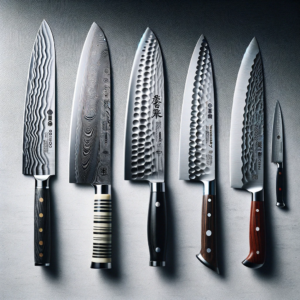 For centuries, the exquisite patterns and fabled sharpness of Damascus steel have elevated it to the status of a work of art in knife-making. The word “Damascus,” which has its roots in ancient Syria, describes the medieval methods of producing steel in the Near East. By using these methods, blades with distinctive mottled or wavy patterns that resembled flowing water were produced. Damascus knives are treasured for their exceptional qualities and are more than just tools—they are works of art with a rich history.
For centuries, the exquisite patterns and fabled sharpness of Damascus steel have elevated it to the status of a work of art in knife-making. The word “Damascus,” which has its roots in ancient Syria, describes the medieval methods of producing steel in the Near East. By using these methods, blades with distinctive mottled or wavy patterns that resembled flowing water were produced. Damascus knives are treasured for their exceptional qualities and are more than just tools—they are works of art with a rich history.
The Making of a Damascus Knifes
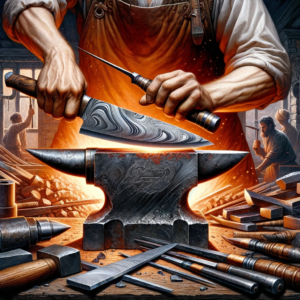 Crafting a Damascus knife involves both artistic and scientific techniques. Several kinds of steel and iron are layered, forge-welded together, and repeatedly folded in this process. On the blade, this process produces the unique patterns. A softer, low-carbon steel for flexibility and a harder, high-carbon steel for sharpness are the two main steel types used to make modern Damascus blades. This combination produces a blade that is long-lasting and razor-sharp.
Crafting a Damascus knife involves both artistic and scientific techniques. Several kinds of steel and iron are layered, forge-welded together, and repeatedly folded in this process. On the blade, this process produces the unique patterns. A softer, low-carbon steel for flexibility and a harder, high-carbon steel for sharpness are the two main steel types used to make modern Damascus blades. This combination produces a blade that is long-lasting and razor-sharp.
-
- Choosing the Right Materials
Selecting the right materials is essential when creating Damascus knives. A blade with superior quality will be more resilient and sharp. Because of their high carbon content and nickel layers that accentuate the contrasting patterns, knife makers frequently combine 1095 and 15N20 steels.
-
- Forging and Folding
The chosen steels are forge-welded together after being heated to a high temperature. The steel is then folded and hammered several times by the smith. This folding technique ensures a stronger blade by removing impurities and producing distinctive patterns.
-
- Shaping and Sharpening
The smith shapes the blade once the required number of layers is reached. To achieve the ideal edge, this requires precise honing, tapering, and grinding. Sharpening is a labor-intensive and skillful process that requires a steady hand and an acute eye.
Damascus patterns: An attractive visual appeal
The distinctive pattern, which is never the same on two knives, is what makes a Damascus knife so beautiful. From delicate waves to striking, contrasting lines, these patterns can take many forms. These patterns’ artistry is not merely decorative; rather, it serves as a demonstration of the knife maker’s talent and commitment.
Damascus Knives: Their Features
Beyond their aesthetic appeal, Damascus knives are highly valued for their functionality. Here are a few essential qualities:
- Sharpness: The steel’s high carbon content produces an exceptionally sharp edge that is ideal for precise cutting.
- Durability: Damascus knives are made with a layering technique that produces a strong, shatter-resistant blade.
- Edge Retention: Compared to regular knives, Damascus knives keep their sharp edge longer and need less frequent honing.
- Flexibility: These knives are less likely to shatter under pressure because of the combination of hard and soft steel layers.
Caring for Your Damascus Knifes
Maintaining a Damascus knife properly is essential to its lifespan. These are some vital aftercare pointers:
- Cleaning: Always give your knife a hand wash in warm, running water and mild soap. The handle and blade may be damaged by dishwashers.
- Drying: To avoid rust and corrosion, dry your knife right away after washing.
- Maintaining a sharp edge can be achieved by using a whetstone or hiring a professional sharpening service. The blade can be worn down if it is oversharpened.
- Storage: To preserve the blade, keep your knife dry and in a knife block or sheath.
Types of Damascus Knives
There are several types of Damascus knives, and each is appropriate for a particular type of cooking task. Here’s an overview:
1. Chef’s Knife
Chopping, slicing, and mincing are all made easy with the most adaptable kitchen knife. Its wide blade makes handling a variety of foodstuffs simple.
2. Santoku Knife
A multipurpose knife in the style of Japan. Unlike a chef’s knife, it has a shorter, lighter blade that is ideal for chopping, slicing, and mincing.
3. Paring Knife
For precise tasks in the kitchen, such as peeling, a small knife works best. Shrimp deveining and seed removal are made easy with its sharp point.
4. Bread Knife
This bread slicer’s long, serrated blade is made to cut bread without crushing it. Additionally, it is effective at slicing through fruits and vegetables with thick skin.
5. Utility Knife
Not as small as a chef’s knife but bigger than a paring knife, it works well for routine tasks like slicing meat and chopping vegetables.
Choosing the Ideal Damascus Blade for Your Requirements
When choosing a Damascus knife, consider the following factors:
- Blade Length: Select a blade length that provides control and efficiency based on the material you will be cutting.
- Comfort of the Handle: You should be able to hold the handle firmly and comfortably.
- Weight and Balance: A knife with proper balance provides improved control and less fatigue.
- Pattern and Aesthetics: Since these knives are works of art as well, pick a pattern that you find visually pleasing.
Best Damascus Knives on the Market
1. Shun 8-Inch Chef Knife, Classic Style
![]() Chefs in the industry highly recommend this knife. Its VG-MAX steel blade maintains its edge well, and its ebony PakkaWood handle guarantees comfort and longevity.
Chefs in the industry highly recommend this knife. Its VG-MAX steel blade maintains its edge well, and its ebony PakkaWood handle guarantees comfort and longevity.
2. Yoshihiro VG10 16-Layer Japanese Chefs Knife with Hammered Damascus Gyuto
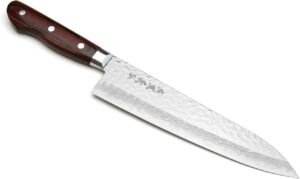 A luxury chef’s knife, ideal for connoisseurs of exquisite Japanese workmanship. A long-lasting edge is guaranteed by the VG10 steel, and the mahogany handle offers style and traction.
A luxury chef’s knife, ideal for connoisseurs of exquisite Japanese workmanship. A long-lasting edge is guaranteed by the VG10 steel, and the mahogany handle offers style and traction.
3. DALSTRONG Shogun Series X Gyuto Chef Knife
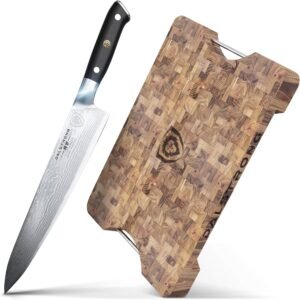 The high-carbon Damascus blade of the Shogun Series X, which is well-known for its durability, holds its edge even after prolonged use. Comfort and control are offered by its ergonomic handle.
The high-carbon Damascus blade of the Shogun Series X, which is well-known for its durability, holds its edge even after prolonged use. Comfort and control are offered by its ergonomic handle.
4. J.A. Henckels Professional ‘S’ Chef’s Knife by Zwilling
![]() This knife combines Damascus beauty and German precision to create a robust and sharp edge. The classic three-rivet handle provides balance, and the ice-hardened blade guarantees continued sharpness.
This knife combines Damascus beauty and German precision to create a robust and sharp edge. The classic three-rivet handle provides balance, and the ice-hardened blade guarantees continued sharpness.
5. Hollow Edge Wusthof Classic Ikon 7-Inch Santoku
 This Santoku knife, which combines Japanese design and German engineering, is perfect for chopping, slicing, and mincing. Food does not adhere to the blade thanks to the hollow edge’s reduction in drag.
This Santoku knife, which combines Japanese design and German engineering, is perfect for chopping, slicing, and mincing. Food does not adhere to the blade thanks to the hollow edge’s reduction in drag.
You can better comprehend the variations and special qualities of each model by using this table.
| Knife Model | Blade Length | Steel Type | Handle Material | Ideal Usage | Notable Feature |
|---|---|---|---|---|---|
| Shun Classic 8-Inch Chef Knife | 8 inches | VG-MAX Damascus steel | Ebony PakkaWood | Versatile kitchen tasks | Known for its exceptional edge retention |
| Yoshihiro VG10 16-Layer Hammered Damascus Gyuto | Varies, typically around 8.25 inches | VG10 16-layer hammered Damascus | Mahogany | Precision cutting and slicing | Unique hammered finish for non-stick properties |
| DALSTRONG Chef Knife, Shogun Series X Gyuto | 9.5 inches | High-carbon Damascus steel | Military-grade G10 | Heavy-duty chopping and slicing | Renowned for its toughness and durability |
| ZWILLING J.A. Henckels Professional ‘S’ Chef’s Knife | 8 inches | Special formula high-carbon stainless steel with Damascus design | Traditional three-rivet | General kitchen tasks | Ice-hardened blade for lasting sharpness |
| Wusthof Classic Ikon 7-Inch Santoku, Hollow Edge | 7 inches | High-carbon stainless steel with Damascus pattern | Polyoxymethylene | Slicing, dicing, and mincing | Hollow edge design to prevent food from sticking |
Analysis of Damascus knives:
- Blade Length: At 9.5 inches, the DALSTRONG’s blade is the longest, giving it more leverage for difficult jobs. There are some differences in the other blade lengths. The Wusthof Santoku is the shortest, making it easier to handle and use for precise cutting.
- Steel Type: All knives are made from high-carbon steel, which is required for both sharpness and durability. The Shun and Yoshihiro models go into great detail about VG10 steel, which is well known for its remarkable edge retention.
- Material for Handle: A range of conventional and modern woods, including mahogany and PakkaWood, as well as traditional woods like G10, combine style and functionality in handle materials.
- Ideal Use: While every knife has some versatility, each one also has unique benefits. The Yoshihiro, for instance, is excellent for non-stick slicing, while the Wusthof Santoku is ideal for jobs needing accuracy.
- Notable Features: Each knife has a unique feature that makes it more useful in the kitchen. Examples of these features are the Wusthof’s hollow edge design and the Shun’s edge retention.
You ought to be able to evaluate and choose the ideal Damascus knife based on your culinary preferences and requirements by using this table. Remember at all times that the perfect knife is the one that complements your cooking style and is comfortable to hold.
How to Care for and Sharpen Damascus Knives
For optimal preservation of your Damascus knife:
- Frequent Honing: To keep the blade’s edge sharp, use a honing rod on a regular basis.
- Professional Sharpening: To guarantee peak performance, get your knife professionally sharpened on a regular basis.
- Steer clear of hard surfaces; cutting on metal, glass, or stone can cause the blade to become dull. Instead, use cutting boards made of plastic or wood.
Conclusion
Damascus knives are more than just practical kitchenware; they are examples of centuries-old artistry and engineering. Having a Damascus knife enhances your cooking experience, whether you are a home cook or a professional chef. Recall that years of flawless performance from your knife can be ensured with proper care and upkeep.
To keep your damascus knife sharp, read this article.
Other Damascus knives from Amazon
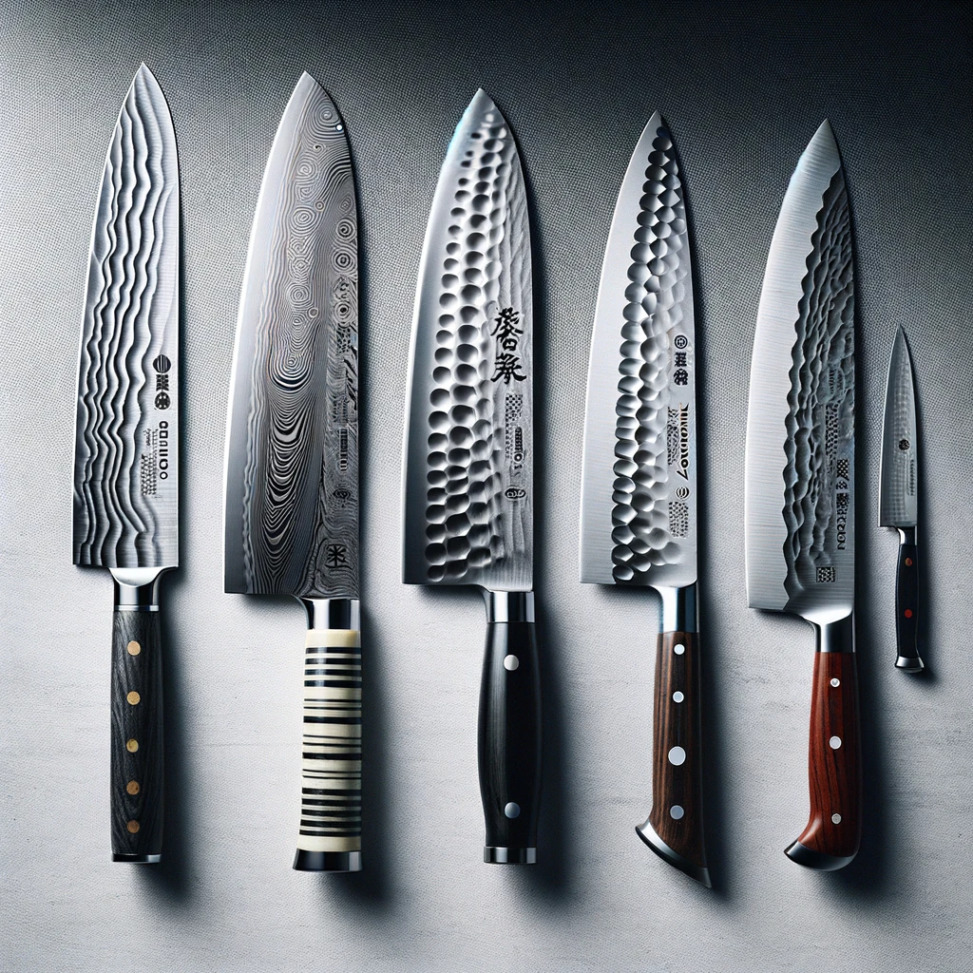
Hairstyles
Wow that was unusual. I just wrote an very long comment but after I clicked submit my comment didn’t show up. Grrrr… well I’m not writing all that over again. Anyway, just wanted to say great blog!